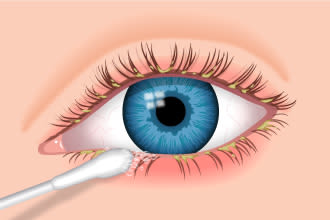Blepharitis is a common eyelid inflammation with symptoms that can include burning, flaking, crusting, tearing, irritation, itching, redness in eyelid margins, and a foreign body sensation. It can be associated with a low-grade bacterial eye infection, dry eyes, or certain types of skin conditions such as rosacea.
Blepharitis has two basic forms:
- Anterior blepharitis affects the outside front of the eyelid where eyelashes are attached.
- Posterior blepharitis, linked to dysfunction of meibomian glands within the eyelids that secrete oils to help lubricate the eye.
It’s common to have a mixture of both anterior and posterior forms of blepharitis at the same time but in different degrees of severity.
Treatment for Blepharitis
If you are diagnosed with chronic blepharitis, we likely recommend booking an appointment to determine the cause of your eyelid inflammation. At Beckenham Optometrist, we will examine your eyes and eyelids to evaluate whether you have blepharitis and determine what type of blepharitis treatment is most appropriate.
Typically, blepharitis treatment includes:
-
Eyelid scrubs
Gently scrubbing your eyelids removes the buildup of biofilm and excess bacteria from your lid margins. We typically recommend a daily regimen of warm compresses and lid scrubs to clean your eyelids and reduce the number of bacteria and Demodex mites on your eyelids.
Cleaning agents may include prescription eyelid cleansers or non-prescription eyelid cleansing pads.
-
In-practice procedures
Though eyelid scrubs at home are helpful, in-office eyelid hygiene procedures often are recommended for more effective blepharitis treatment. Possible procedures include:
1. Electromechanical lid margin debridement to efficiently remove bacteria, biofilm, and Demodex mites from your eyelids and open clogged meibomian glands.
2. Thermal pulsation treatment with a device that melts and expresses material obstructing the meibomian glands.
3. Intense pulsed light (IPL) therapy to open clogged eyelid glands and resume normal flow of oils into the tear film.
-
Medicated eye drops and/or ointments
In some cases, we also may prescribe topical medicines to destroy excess blepharitis-causing bacteria or other microbes on the eyelids — particularly if there is a risk of infection or it appears you have pink eye or some other type of eye infection as well as blepharitis.
Eyelid hygiene tips
Eyelid hygiene is very helpful to treat and control blepharitis, but only if performed properly.
To begin, use a clean, warm compress to melt any blocked residue in the oil-secreting meibomian glands in your eyelids. Here’s how:
- Wash your hands, then dampen a clean bathroom flannel with warm (nearly hot) water.
- Place the bathroom flannel over your closed eyelids for several minutes.
- Then gently rub your eyelid margin with the bathroom flannel before opening your eyes. (Don’t press hard on your eye.)
In your appointment, we will make recommendations regarding how often to use a warm compress and how long to keep it in place. When you first begin treatment, you may be instructed to do this several times daily, for about five minutes each time. Later on, you might only need to apply the compress once daily.
Cleaning your eyelids
Use a cotton-tipped swab to apply a cleaning solution recommended by your eye doctor. Rub gently around the edges of your upper and lower eyelids, but do not get a cleaning solution in your eye.
The goal of blepharitis treatment is to return your eyelids to a normal, healthy state.
To clean your eyelids:
- Wash your hands, then moisten a clean bathroom flannel, cotton bud, or gauze pad with the cleaning solution.
- Gently wipe your eyelashes and lid margin.
- Rinse with warm water.
- Repeat the process for your other eye, using a different washcloth, swab, or pad.
- It’s a good idea to minimise the use of eye makeup when you have blepharitis because mascara and other makeup can interfere with eyelid hygiene.
If you wear contacts or glasses
If you develop blepharitis while wearing contact lenses, you should discontinue wearing your contacts until the blepharitis has been successfully treated. Wearing contacts when you have eyelid inflammation can result in bacteria and other debris sticking to your lenses and causing pink eye or potentially more serious eye diseases.
Beckenham Optometrist has been operating in Avalon Beach for over 20 years. The team is passionate and dedicated to providing you and your eyes the best service possible. To make an appointment call the team on 9918 0616 or follow the link below.



